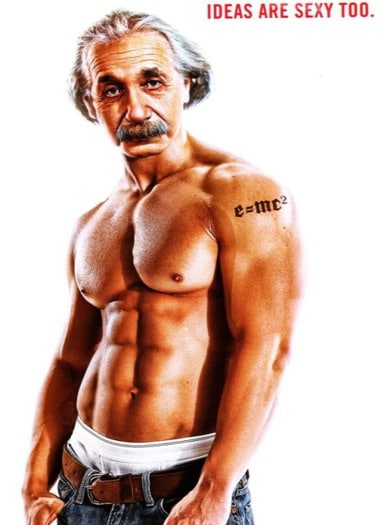Is it just me, or has there been a larger-than-usual number of right of publicity complaints filed lately by celebrities against advertisers? Among others, we’ve seen Lindsay Lohan’s action against E*Trade and Hulk Hogan’s lawsuit against the Post cereal company. In each of these cases, the primary legal issue is whether the celebrity’s identity, or “persona,” has actually been used by the advertiser. This month brought an even more straightforward right of publicity action involving the use of an Albert Einstein photo in a print ad for General Motors. What’s amazing about this one is that, not only did the advertiser not get permission to use what is clearly Einstein’s likeness, but that it placed Einstein’s head on the body of a shirtless underwear model. Which all leads me to wonder: is our bailout money going to pay for this?…
The facts are pretty simple. Plaintiff Hebrew University of Jerusalem (HUJ) claims to own all of Albert Einstein’s publicity rights. Einstein has been a veritable cash cow for HUJ, netting $18 million per year for the university — enough to make him one of the highest earning deceased celebrities, and enough for me to wonder whether I should have chosen a career in theoretical physics.
HUJ’s complaint alleges that GM used Einstein’s likeness, without permission, in a four page spread, which ran in People’s “Sexiest Man Alive” issue in the fall of 2009:

Apparently, only the head on the first page is Einstein’s (I know, I was surprised too). The body belongs to an unidentified shirtless “underwear model” sporting an “E=mc2” tattoo on his shoulder. On the second page is the tagline “IDEAS ARE SEXY TOO.” The third page states “THAT’S WHY WE GAVE IT MORE IDEAS PER SQUARE INCH,” referring to a new GMC SUV, which is shown on page four.
I’ve been down this road before with right of publicity cases. In 2003, I represented actor Tom Skerritt (perhaps best known as Tom Cruise’s macho flight instructor in “Top Gun”) when a dietary supplement company superimposed his head on a shirtless male model in an advertisement for an erectile dysfunction pill. We got a quick settlement and a public apology from the supplement company. A few years earlier, we represented Dustin Hoffman in a case against Los Angeles Magazine, in which the actor’s head was superimposed on the body of a male model wearing a Richard Tyler gown and Ralph Lauren high heels. After winning in the trial court, the Ninth Circuit Court of Appeals held that the photograph (which did not appear in a “traditional” advertisement), was protected by the First Amendment. (Not that I’m bitter or anything.)
The Einstein case is much closer to Skerritt’s than Hoffman’s, because there is no question that the GM photo appears in a commercial advertisement, and is therefore entitled to significantly less constitutional protection that an editorial use. It’s hard to believe that this case won’t settle quickly, with a healthy contribution to HUJ’s endowment fund.
So what was GM thinking? Well, its spokesperson claims that it purchased the rights to Einstein’s image from a “reputable firm,” which guaranteed that its clients have the rights to use the images selected.
Given the way the advertising industry works, this is somewhat hard to believe. My guess (and I’m only speculating) is that GM’s advertising agency merely licensed the copyright in the Einstein image from a stock photo house. If true, this would insulate GM from a copyright infringement claim, but wouldn’t give the company the right to use Albert Einstein’s likeness for commercial purposes. It’s important to remember that the right of publicity in Einstein’s likeness is separate from the copyright in any individual Einstein photograph. If an advertiser wants to use Einstein in an advertisement, it needs to license both rights. It sounds to me like either GM’s advertising agency didn’t really get “all rights” from the stock photo house, or else the stock photo house represented that it owned rights that it really didn’t have. Either way, someone screwed up. It’s not as bad as that guy who left the iPhone prototype in a bar, but it’s still bad enough to warrant one of those Southwest Airlines “Wanna Get Away?” ads.
If the lawsuit proceeds, HUJ will no doubt argue that Einstein’s endorsement value as an erudite man of science has been tarnished by his appearance as a topless model, and that the fair market value of the use should be increased accordingly. On the defense side, its possible that GM will argue that this use is somehow “transformative” and therefore protected, but I don’t think this argument would go very far. It’s much more likely that GM will simply blame (and perhaps even file a cross-claim against) the supplier of the photo at issue. However, chances are that the photo house only licensed the Einstein head, and that it was the advertising agency that created the head-on-shirtless-body composite image. This back-and-forth finger-pointing could make for an interesting sideshow, but will only inure to the benefit of the plaintiff. My guess is that, rather than fight out in the open, the defendant will settle quickly, and then fight about apportioning liability behind the scenes.
Either way, the case provides two valuable lessons for advertisers and agencies alike. First, don’t forget about the right of publicity, which almost always requires a license separate from copyright alone. And second, washboard abs and genius ideas may both be sexy, but sometimes, there’s nothing more desirable than proper rights clearance.






